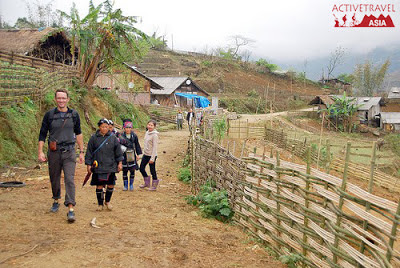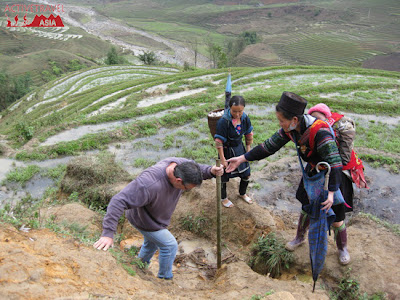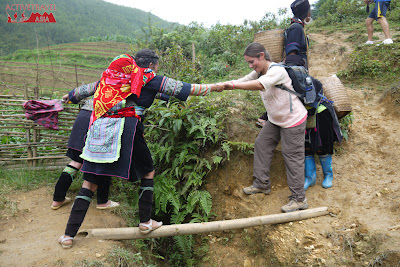Tripatini
the world's smartest travel social network
In Vietnam, Visiting the Villages of the Sapa and Other Ethnic Minorities
 |
| Visiting minority villages |
At an elevation of 1,600 meters, Sapa is a delightful former French hill station in the mountainous region of Vietnam's northwest, close to the Chinese border. The region is home to many ethnic minority groups, each with its own traditional and colorful attire. A visit here includes a trek through the hills and valleys of the Sapa region, discovering several different minorities along the way and staying overnight accommodation in the hospitable villages of the Giay and Tay ethnic minorities. The apparent hardships are worth it though as you walk through some of the most spectacular scenery that Vietnam has to offer and experience unique village culture.
The following tips can make your experience both more enjoyable and considerate of the locals:
Visit in Small Groups
For many people, one of the highlights of travelling in Sapa is the experience of visiting minority villages.
If at all possible, it’s preferable to visit these villages as a part of a small group, ideally four people or less, as this causes least disruption and allows for greater communication. There is a whole debate about the ethics of cultural tourism and its negative impact on traditional ways of life. Most villagers are genuinely welcoming and hospitable to foreigners, appreciating contact with Westerners and the material benefits which they bring.
 |
| Dress modestly, in long trousers |
Remember You are a Guest
Behavior that we take for granted may cause offence to some ethnic minority people; remember you are a guest. Apart from being sensitive to the situation and keeping an open mind, be courteous and follow the following simple guidelines
- Dress modestly, in long trousers or skirt and T-shirt or shirt.
- When taking photographs, be sensitive to people’s wishes when taking photographs, particularly of older
people who may be suspicious of cameras; always ask permission first.
- Only go inside a house when invited, and remove your shoes before entering.
- Small gifts, such as fresh fruit from the local market, are always welcome. However, there is a view that
even this can foster begging, and that you should only ever give in return for some service or as a sign of
appreciation for hospitality. A compromise is to buy craftwork produced by the villagers - most communities
should have some embroidery, textiles or basketry for sale.
 |
| Trekking through villages |
- As a mark of respect, learn the local term of address, either in dialect or at least in Vietnamese, such as
chao ong and chao ba.
- Try to minimize your impact on the often fragile local environment; take litter back to the towns and be
sensitive to the use of wood and other scarce resources.
- Growing and using opium is illegal in Vietnam and is punished with a fine or prison sentence; do not
encourage its production by buying or smoking opium.
Trekking Practicalities
Foreigners are now permitted to stay in minority villages, which has opened up the possibility of trekking and created a small industry focused on Sapa.You can arrange a tailored individual programme through a tour agent; it is important to ask for a guide with a good level of English who is familiar with the villages and the minorities’ culture traditions.
Note that it’s not a good ideal to turn up at a minority’s village and expect to find accommodation; you host may find themselves in trouble with the authorities and there’s also a growing problem of petty crime, particularly around Sapa. Far better to make arrangements beforehand with someone who know the current situation. If you go with local guide, you are also less likely to cause offence and will probably have a more interesting time.
Clothing For Hiking in the Mountains
It is very important to ear the right clothing when walking in these mountains; strong boots with ankle support are the best footwear, though you can get away with training shoes in the dry season. Choose thin, loose clothing - long trousers offer some protection from thorns and leeches; wear a hat and sun block; take plenty of water; rain coats and carry a basic medical kit.
If you plan on spending the night in a village you will need warm clothing as temperatures can drop to around freezing, and you may want to take a sleeping bag, mosquito net and food, though may be provided on organized tours.
Carrying a Stick When Trekking
Finally, dogs can be a problem when entering minority villages, so it is a good ideal to carry a strong stick when trekking, and always be watchful for the poisonous snakes that are common in this area.
We offer a Sapa Trekking & Homestay itinerary from ACTIVETRAVEL ASIA: 4-day tour with 2-day trek and 2-night homestay. Read more for detail: http://www.activetravelvietnam.com/tour.php?op=detail&tourId=25
Videos
Groups
-
India
173 members
-
Tour Operators
873 members
-
Ireland
93 members
-
South Dakota
17 members
-
Azerbaijan
17 members
-
Shopping the World
55 members
-
Tech for Travel/Hospital…
87 members
-
Andorra
26 members
-
Online Corner
75 members
-
Minnesota
22 members
-
Backpackers & Hostels
84 members
-
Portugal
60 members
-
Turks and Caicos
26 members
-
Agritourism/Farmstays
72 members
-
Zambia
21 members
© 2025 Created by EnLinea Media.
Powered by
![]()
Badges | Report an Issue | Privacy Policy | Terms of Service
You need to be a member of Tripatini to add comments!
Join Tripatini